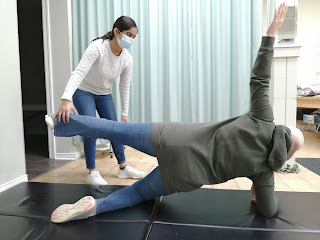Virtual Care
It feels like a new era that we are offering Virtual Care but in reality, some physios are offering virtual care for years as their regular day-to-day practice. It's not something new but it's the only option right now for non-urgent cases during the pandemic season. Some people embrace it as it is empowering and convenient. They feel they are enabled to help themselves and not dependent on anyone else. They also like the convenience of not leaving their home. Some people though don't see how it would change their pain without therapist putting hands on them or providing modalities as treatment. What is physiotherapy exactly? It has become a question for all of us to answer and to define again. However, maybe nothing has changed; there are just different ways to deliver physiotherapy and different priorities to consider when choosing how to deliver the service.
As a physiotherapist practicing manual and exercise therapy for years along with modalities, it is a big change to provide exercise instructions only through video conferencing. Adding self applied manual therapy is a big focus when I offer virtual care. People can perform simple myofascial release and active release on their neck, shoulders and forearms for example. Self applied manual therapy requiring people to have adequate hand function so it might not be for everyone. It is however, a very empowering tool for people to have. Exercise technique and sequence polishing is also a big focus of mine to ensure people understand why they are asked to do what they are doing and how to do it to make most out of it. People's mindset change through education helps them to respond better in virtual care as well. They need to value independence and the importance of regular independent prescriptive exercises. Following the prescription correctly is what we need to make sure during the virtual visit and progress the exercises properly and timely.
During the in-person visits, I often focus on hands-on treatment and relying on patients to tell me if they have questions regarding the home exercises. Often they are performing incorrectly and not getting the right area effectively but unable to know that they can doing it differently. That results in them asking for more hands-on therapy and not gaining any improvement. Virtual visits allow us time to focus on exercise polishing to make sure people are doing what they are supposed to do independently to get better. One therapist puts it this way that we are teaching people to "super not need us". It is a bit of struggle on the therapist's side but the reality is that people will always need our professional opinion. They are trained on only this specific technique to be performed on this specific time frame of recovery. They need us to progress, to ensure and to guide them through the whole process. A professional athlete always needs a good coach. They never compete by themselves!
As a physiotherapist practicing manual and exercise therapy for years along with modalities, it is a big change to provide exercise instructions only through video conferencing. Adding self applied manual therapy is a big focus when I offer virtual care. People can perform simple myofascial release and active release on their neck, shoulders and forearms for example. Self applied manual therapy requiring people to have adequate hand function so it might not be for everyone. It is however, a very empowering tool for people to have. Exercise technique and sequence polishing is also a big focus of mine to ensure people understand why they are asked to do what they are doing and how to do it to make most out of it. People's mindset change through education helps them to respond better in virtual care as well. They need to value independence and the importance of regular independent prescriptive exercises. Following the prescription correctly is what we need to make sure during the virtual visit and progress the exercises properly and timely.
During the in-person visits, I often focus on hands-on treatment and relying on patients to tell me if they have questions regarding the home exercises. Often they are performing incorrectly and not getting the right area effectively but unable to know that they can doing it differently. That results in them asking for more hands-on therapy and not gaining any improvement. Virtual visits allow us time to focus on exercise polishing to make sure people are doing what they are supposed to do independently to get better. One therapist puts it this way that we are teaching people to "super not need us". It is a bit of struggle on the therapist's side but the reality is that people will always need our professional opinion. They are trained on only this specific technique to be performed on this specific time frame of recovery. They need us to progress, to ensure and to guide them through the whole process. A professional athlete always needs a good coach. They never compete by themselves!




have you benefited from virtual physiotherapy? let us know!
ReplyDelete